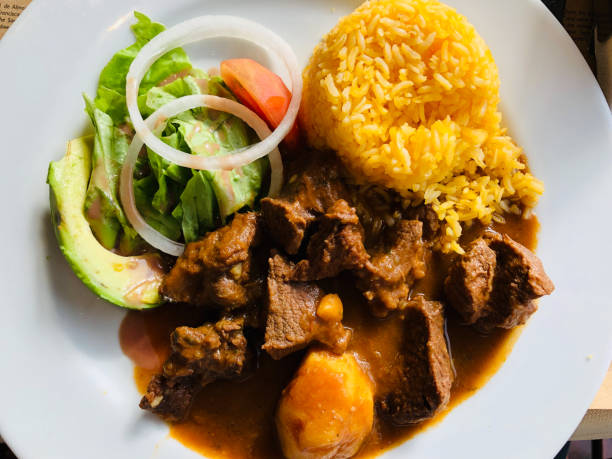Cooking lamb stew can seem tricky at first, especially if you’re not used to making stews.
But don’t worry, I’ve got your back.
I’ll guide you through each step, from choosing the right cuts of lamb to getting those flavours just right.
We’ll start with prepping the meat and veggies, then move on to browning the lamb to lock in that juicy taste.
I’ll show you how to simmer everything to perfection, creating a stew that’s both hearty and delicious.
Let’s get started!
Ingredients
Before we dive into the cooking process, let’s make sure you have all the necessary ingredients.
Here’s what you’ll need for serving approximately 4 people:
Meat and Vegetables
- Lamb: 1 kg of lamb, preferably shoulder or leg, cut into 2-3 cm cubes. Lamb is a popular meat in South Africa and provides a rich, robust flavour to the stew.
- Onions: 2 large onions, finely chopped. Onions are a base flavour for many South African dishes.
- Carrots: 3 large carrots, peeled and sliced. Adds sweetness and colour.
- Potatoes: 4 large potatoes, peeled and cut into chunks. They thicken the stew and make it hearty.
- Garlic: 3 cloves of garlic, minced. Essential for a depth of flavour.
- Peas: 1 cup of frozen peas, a typical addition to add freshness and a pop of colour.
Liquids and Flavourings
- Beef stock: 1 litre, to provide a rich base for the stew.
- Tomato paste: 2 tablespoons, for a tangy depth.
- Red wine: 1 cup, optional, but adds a richness and complexity to the flavour.
- Worcestershire sauce: 2 tablespoons, for a subtle tang and depth.
- Fresh herbs: A bouquet garni of thyme, rosemary, and bay leaf, tied together. These herbs are common in South African cooking and will infuse your stew with delightful aromas.
Seasonings
- Salt and pepper: To taste, essential for enhancing all the flavours.
- Flour: 2 tablespoons, to dust the lamb and thicken the stew.
Equipment
- Large pot or Dutch oven: Essential for cooking stews, as it distributes heat evenly.
- Wooden spoon: To stir the ingredients without scratching your pot.
- Knife and chopping board: For prepping the ingredients.
- Measuring cups and spoons: For accurate ingredient measurements.
Method
Preparing the Ingredients
- Prep the Lamb: Pat the lamb dry with paper towels. This helps in browning the meat. Season the lamb cubes with salt and pepper, then dust with flour. This not only helps in thickening the stew but also gives the lamb a nice crust when browned.
- Chop the Vegetables: Ensure all your veggies are chopped and ready. Consistent sizes mean even cooking.
Browning the Lamb
- Heat the Pot: Place your pot on medium-high heat and add a splash of oil. Once hot, add the lamb cubes in batches. Don’t overcrowd the pot, as this will steam the meat instead of browning it.
- Brown All Sides: Take your time to brown all sides of the lamb cubes. This step is crucial for flavour development. Once browned, set the lamb aside.
Sautéing the Vegetables
- Onions and Garlic: In the same pot, reduce the heat to medium and add the onions and garlic. Cook until the onions are translucent and soft.
- Carrots and Potatoes: Add the carrots and potatoes, stirring for a few minutes to coat them in the flavours.
Deglazing the Pot
- Add Wine: If using wine, pour it into the pot now to deglaze it. Scrape up any browned bits from the bottom of the pot, as these are flavour gold.
Adding the Lamb and Liquids
- Return the Lamb: Bring the browned lamb back into the pot.
- Add Stock and Tomato Paste: Pour in the beef stock and stir in the tomato paste, ensuring it’s well distributed.
- Herbs: Add your bouquet garni, pushing it into the liquid.
Simmering the Stew
- Bring to a Boil: Increase the heat to bring the stew to a gentle boil.
- Reduce to a Simmer: Once boiling, reduce the heat to low, cover, and let it simmer gently. This slow cooking process is key to tenderising the lamb and developing the flavours. Expect this to take about 1.5 to 2 hours. Stir occasionally and check the liquid level, adding more stock or water if it seems too thick.
Finishing Touches
- Peas and Seasoning: In the last 10 minutes of cooking, add the frozen peas. Taste the stew and adjust the seasoning with more salt and pepper if needed.
- Remove Herbs: Don’t forget to fish out the bouquet garni before serving.
Serving
Lamb stew is traditionally served hot, often with a side of crusty bread or over a bed of rice to soak up the delicious gravy.
It’s a comforting dish that’s perfect for sharing with family or friends.
Tips for Success
- Browning the Meat: Don’t rush the browning process. It’s essential for building the stew’s flavour foundation.
- Low and Slow: The key to a tender lamb stew is cooking it on a low heat for a long time.
- Taste as You Go: Adjust the seasoning as needed, especially after the stew has simmered for a while.
Cooking a lamb stew might seem daunting at first, but by following these detailed steps, you’ll be able to create a warming and satisfying dish that’s perfect for any occasion.
So have fun with it and don’t be afraid to make it your own by tweaking the recipe to suit your tastes.
Enjoy your culinary adventure!

